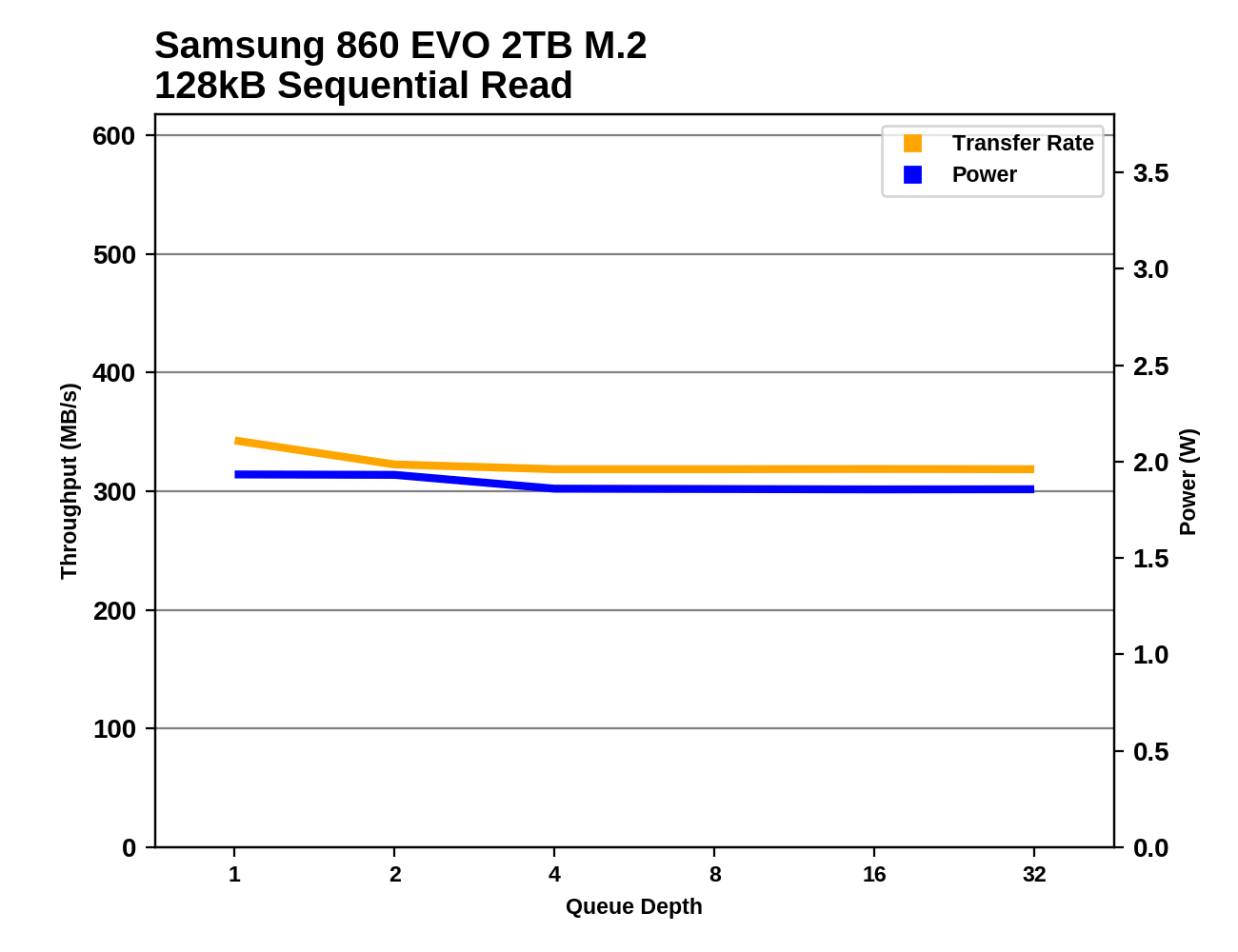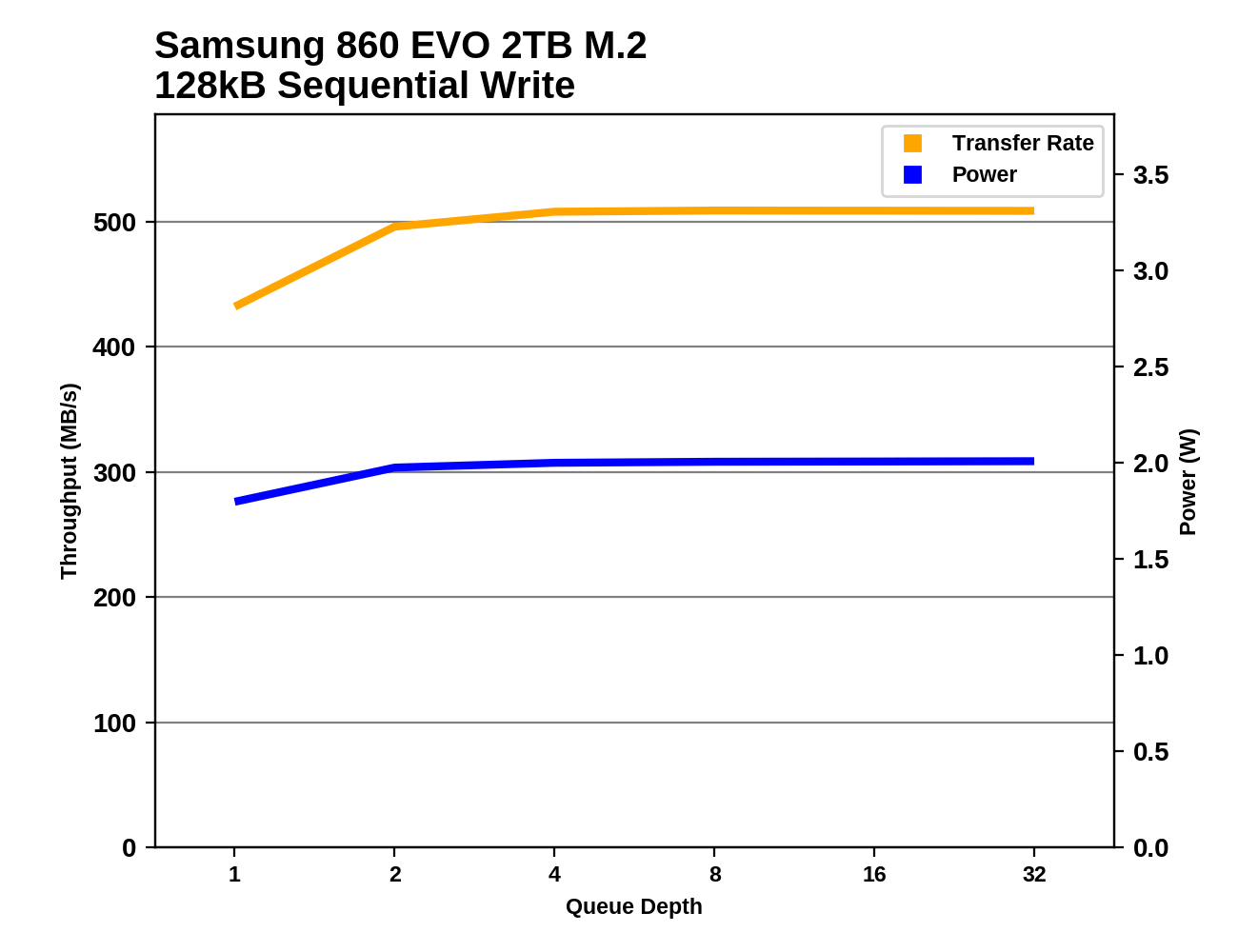The Latest High-Capacity M.2: The Samsung 860 EVO 2TB SSD, Reviewed
by Billy Tallis on February 14, 2018 1:40 PM ESTSequential Read Performance
Our first test of sequential read performance uses short bursts of 128MB, issued as 128kB operations with no queuing. The test averages performance across eight bursts for a total of 1GB of data transferred from a drive containing 16GB of data. Between each burst the drive is given enough idle time to keep the overall duty cycle at 20%.

The burst sequential read performance of the 850 EVO was no longer up to par, but the 860 EVO fixes that and puts Samsung back on top among TLC drives.
Our test of sustained sequential reads uses queue depths from 1 to 32, with the performance and power scores computed as the average of QD1, QD2 and QD4. Each queue depth is tested for up to one minute or 32GB transferred, from a drive containing 64GB of data.

The sustained sequential read performance of the 860 EVO takes a surprising step backward, falling behind the Crucial and SanDisk drives. This test runs on a data set that has been fragmented by some random writes, and the performance regression is may be due to an increase in NAND page sizes with Samsung's 512Gb 64L TLC, making more work for the drive to unravel its internal fragmentation.

In spite of the performance regression, the 860 EVO still manages to slightly improve power efficiency on the sequential read test, bringing it close to the SanDisk Ultra 3D.
 |
|||||||||
The Samsung 860 EVO shows very little dependence on queue depth for either performance or power consumption. Its power consumption is just under 2W at this speed, while the 860 PRO draws just over 2W when saturating the SATA link.
Sequential Write Performance
Our test of sequential write burst performance is structured identically to the sequential read burst performance test save for the direction of the data transfer. Each burst writes 128MB as 128kB operations issued at QD1, for a total of 1GB of data written to a drive containing 16GB of data.

The burst sequential write speed of the 860 EVO is the same as the 850 EVO and 850 PRO. The Crucial MX300 and 4TB 860 PRO are slightly faster, but overall there isn't much variation on this test.
Our test of sustained sequential writes is structured identically to our sustained sequential read test, save for the direction of the data transfers. Queue depths range from 1 to 32 and each queue depth is tested for up to one minute or 32GB, followed by up to one minute of idle time for the drive to cool off and perform garbage collection. The test is confined to a 64GB span of the drive.

The 860 EVO saturates the SATA bus on the longer sequential write test that hits higher queue depths. Performance is a few MB/s faster than the 850 EVO, but that is an insignificant difference.

Almost all of these SSDs offer near identical performance on this test, but their power efficiency varies greatly. The 860 EVO is almost on par with the 860 PRO, and both are far more efficient than their predecessors and their current competition.
 |
|||||||||
As with random writes, the sequential write performance of most of these drives saturates around QD4. The Samsung 860 EVO draws almost exactly 2W, lower than anything else except the 860 PRO.










32 Comments
View All Comments
yankeeDDL - Friday, February 16, 2018 - link
Today, on Newegg, the 860 Evo m.2 250GB is $77.99. The 960 Evo is $98.99. It seems to me a relevant question to understand if $21 are worth the difference. If the 960 "utterly destroys" the 860 (and, therefore, all other devices in the comparison), then why even bother, given $21 price difference?Luckz - Monday, April 30, 2018 - link
Because it destroying the 960 only matters if you copy files from left to right. Sequential writing.PeachNCream - Thursday, February 15, 2018 - link
I'm not sure what I was expecting, but this feels like a slightly disappointing result. There's nothing outwardly wrong about the 860 EVO, but it isn't very far ahead of the competition and the price seems too high for what you get back.Samus - Thursday, February 15, 2018 - link
Is the 2TB m.2 drive single sided?OddFriendship8989 - Thursday, February 15, 2018 - link
I'm always kinda annoyed by these comparisons. Yes the obvious 850 vs 860 comparison was done, but what about the 960? I think both the 860 EVO and 860 Pro should be tested against the 960 and compared. It gives people perspective if they should shell out extra $$ or not. It always seems to me a lot of these benches are lazy. I know it takes time to do comparisons, but that's why we trust you reviewers.saketh_ravirala - Sunday, February 18, 2018 - link
What is the main difference between 850 EVO and 860 EVO?If it is a upgraded version, then why is there a slight performance loss?
If i get both for the same price, which one should i buy!!!
yifu - Wednesday, February 21, 2018 - link
Cheapestyifu - Wednesday, February 21, 2018 - link
If Same price, Which box looks better to you. At this level, there is no difference you will ever knowzodiacfml - Tuesday, February 20, 2018 - link
Reading the first few pages, it felt that Samsung has not done anything substantial. In the last pages, it can be see that the gains are in the mixed random load. They optimized for this load which is logical!peevee - Tuesday, February 20, 2018 - link
What's the point of making iit m.2 and then only giving it SATA?